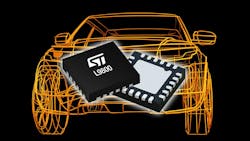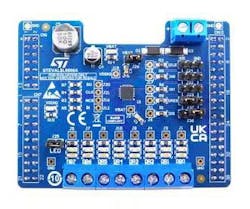8-Channel Low-Side Driver Features Failsafe Limp-Home Mode
What you’ll learn:
- The driver supports SPI control and emergency parallel inputs for limp-home mode, even without digital supply, suiting it for space-constrained automotive applications.
- An input mapping function makes it possible to connect the input pins to different outputs.
- If the primary microcontroller fails, an external safety microcontroller can intervene to control the parallel inputs.
A low-side driver connects a load to ground via a switching element placed between the load and the ground, effectively grounding one side of the load when the switch is closed. Low-side drivers help maximize the potential of a design by reducing switching losses, increasing a system's resiliency to noise and improving system density to enable an efficient, reliable design.
While a high-side driver is responsible for driving the upper switch (high side) of the power device, the low-side driver controls the lower switch (low side).
On this front, STMicroelectronics developed the L9800, an 8-channel low-side driver intended for automotive applications. It’s said to be compatible with resistive, inductive, and capacitive loads.
Diagnostic, Protection, and Limp-Home Capabilities
Designed particularly for driving relays, LEDs, and motors in automotive or industrial applications, the device offers diagnostic and protection functionalities such as open load, overcurrent, and overtemperature detection. The eight output channels can be driven by Serial Peripheral Interface (SPI) or dedicated parallel inputs.
Limp-home functionality is present, maintaining essential functions for safety and convenience in the event of system failure such as a microcontroller fault or supply undervoltage. Daisy-chain use is available. There’s no constraint on SPI number of bits of devices in the chain, enabling multiple devices to be assembled in a single SPI chain using the same number of microcontroller pins.
The device is able to guarantee a cranking scenario down to VBATT = 3 V, making it suitable for start-stop systems. It also ensures very low quiescent current under RESET.
Two input pins (IN0 and IN1) are available for direct control and pulse-width modulation (PWM). They’re connected to two outputs by default (OUT2 and OUT3). Additional or different outputs can be controlled by the same input pins if programmed by SPI.
The eight output channels can be driven via the SPI interface or alternatively using two dedicated parallel inputs that can be mapped to selected outputs. These pins also allow for emergency hardware control of two default channels even if the digital supply voltage isn’t available. This lets the L9800 operate in limp-home mode, enabling the device to remain operational and provide essential functionality in critical system fault situations.
In addition, the L9800 incorporates two special-purpose pins that enhance safety behavior: the NRES pin, which resets internal registers to their default values, and the DIS pin, which disables all channels.
With continuous real-time diagnostics and open-circuit, short-circuit, overcurrent, and overtemperature protection per channel, the L9800 not only improves vehicle reliability, it eases system-level ISO 26262 certification (the international standard for functional safety of electrical and electronic systems in road vehicles) up to ASIL B. The diagnostic signals are available at the L9800’s SPI port. The port also provides access to the driver’s internal configuration registers for device setup.
The L9800’s bulb-inrush mode makes it possible to drive small lamps of about 2 W or other electronic loads with high input capacitance, with protection against excessive current. Furthermore, the driver ensures safe operation during engine cranking with battery voltage as low as 3V.
L9800 Evaluation Board
To help developers evaluate the benefits of this compact solution, an L9800 evaluation board is available (STEVAL-L9800). The eval board enables control and diagnosis via SPI/parallel inputs, and it supports limp-home and GUI integration.
The platform includes a full-featured 1-MB SPC58 MCU discovery board (AEK-MCUC1MLIT1), which exploits the functionality of SPC582B60E1 Power Architecture microcontrollers with full access to I/O signals and peripherals. It can be plugged into the STEVAL-L9800 board and configured using its dedicated graphical user interface.
The L9800 comes in a 4- × 4-mm TFQFN24 package and is in production now, priced at $0.52 for orders of 1,000 pieces.

